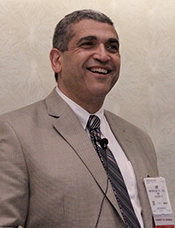
Amr Abouleish, M.D., M.B.A.: ‘A little knowledge, in the wrong hands, is hurting all of us.’
Physician anesthesiologists are constantly battered by conventional economic wisdom. Focusing on turnover time will improve O.R. throughput. Anesthesia providers prefer longer surgeries because anesthesia revenue includes time. Moving from physician-only staffing to medical-direction staffing will reduce staffing costs. Per-provider benchmarks based on FTEs allow accurate comparisons of productivity.
“People think they know something, and when you look more closely, the initial impression is wrong,” said Amr Abouleish, M.D., M.B.A., Pediatric Anesthesiologist at the University of Texas Medical Branch in Galveston. “A little knowledge, in the wrong hands, is hurting all of us.”
Dr. Abouleish explored four economic issues in anesthesiology that are more myth than reality Saturday during “Mythbusters Episode: Anesthesia Economic Issues.” The conventional wisdom is more myth than reality.
The notion that reducing turnover time will improve O.R. throughput seems plausible, he said. Less turnover time would seem to translate into more cases moving through the O.R. every day.
“Administrators like to focus on turnover time because it’s easy to measure,” Dr. Abouleish said. “The reality is that reducing turnover time will not result in even one more case being done in a day.”
The average turnover in the typical full-service hospital is about 38 minutes, he explained, and the typical case takes just over two hours. That works out to three cases per O.R. and two turnovers each workday. Reducing turnover time by 20 percent would save eight minutes per turnover, or 16 minutes per day.
“Instead of focusing on reducing turnover time, focus on delays,” Dr. Abouleish suggested. “If your typical turnover is 40 minutes, don’t worry about cutting one or two minutes — focus on the long turnovers. If you can reduce a 75-minute turnover to 40 minutes, you’ve saved 35 minutes for that one O.R. that day. That’s a greater improvement than the 16 minutes you might save by cutting your average turnover 20 percent.”
Administrators often reason that because anesthesia revenue includes time, anesthesia providers prefer longer surgeries. Good reasoning, he said, but incomplete information and wrong conclusion.
Yes, anesthesiologists bill for time, but they also bill for base units on each case. Given the same eight-hour billable hours in a day, doing more cases generates more base units and higher revenue.
“The real incentive is to do more cases in a day, not fewer,” Dr. Abouleish said. “Longer surgical duration puts you at a financial disadvantage. You can bill more if you do more cases in the same amount of time.”
The idea that moving from physician-only staffing to medical-direction staffing will reduce staffing sounds equally plausible. The median annual compensation for private practice anesthesiologists is $412,000, for academic anesthesiologists $300,000 and for CRNAs $186,000.
The raw numbers are misleading, Dr. Abouleish explained. The typical anesthesiologist works about 2,750 regular hours per year compared to 1,760 hours for the typical CRNA. That is equivalent to $110 to $150 per hour for physicians. CRNAs earn $106 per hour, similar to the median compensation for instructors and assistant professors.
If an academic department needs to cover an additional site, an instructor/assistant professor not only provides clinical services at CRNA cost levels but also provides academic services. Physician-only staffing is more cost effective. In other settings, the total staffing cost depends on the precise mix of sites, hours, types of cases, on-call needs, payers and other factors.
Benchmarking using per-provider measurements based on FTEs can be just as misleading. Comparisons based on the number of cases per FTE appears plausible, but fail to take into account variables such as the number of clinical sites involved, concurrency ratios, the hours of operation and need for a second shift, as well as potential needs for call time and post-call time.
“Comparisons using any per-FTE measurement are nothing more than optical illusions when differences in concurrency or staffing ratios exist,” Dr. Abouleish said. “Comparisons per O.R. are more accurate and more useful.”
